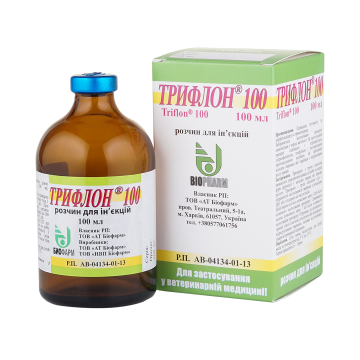TRIFLON® 100
solution for injections
Description
Transparent yellow solution.
Composition
1 ml of the drug contains:
active ingredients: enrofloxacin- 100 mg;
trimethoprim – 50 mg;
Excipient: water for injections.
solution for injections
Description
Transparent yellow solution.
Composition
1 ml of the drug contains:
active ingredients: enrofloxacin- 100 mg;
trimethoprim – 50 mg;
Excipient: water for injections.
Pharmacological properties
ATCvet: QJ01– antibacterials for systemic use. QJ01RA96 quinolones, combinations with other antibacterials
Enrofloxacin is a broad-spectrum antibiotic of the fluoroquinolone group. It has antibacterial action against gram-positive (Staphylococcus spp., Streptococcus spp., Clostridium spp., Listeria monocytogenes, Corynebacterium spp. etc.) and gram-negative microorganisms (Pseudomonas spp., E. coli, Haemophilus spp., Salmonella spp., Klebsiella spp., Proteus spp., Pasteurella spp. etc.), as well as mycoplasma (Mycoplasma spp.) and chlamydiae (Chlamidia spp.). Its mechanism of action is related to inhibition of bacterial DNA-gyrase, resulting in violation of DNA replication in microorganisms.
Trimethoprim is a broad-spectrum antimicrobial product of diaminopyrimidine group. It is effective against gram-positive (Staphylococcus spp.; Streptococcus spp.) and gram-negative microorganisms (Escherichia coli, Klebsiella spp., Salmonella spp.; Pasteurella spp.; Enterobacter spp., Proteus spp.; Shigella spp.; Haemophilus spp.; Chlamidia spp.). Its mode of action is associated with inhibition of bacterial reductase of dihydrofolic acid.
Enrofloxacin is quickly absorbed from injection site and well distributed in body tissues and fluids. Its maximum concentration in blood is reached already in 60-120 minutes. The distribution volume is about 2.8 l/kg, Binding of enrofloxacin to proteins makes 24±2%. Its highest concentrations are observed in bile, kidneys, liver, lungs and reproductive organs. Enrofloxacin is primarily excreted renally. Metabolites are excreted in urine and bile.
Trimethoprim is quickly absorbed from injection site and well distributed in body tissues and fluids. Trimethoprim concentrations in tissues are generally higher than in the blood. High levels of Trimethoprim are noted in lungs, kidneys and liver. Trimethoprim concentration in serum reaches its maximum in 1.5 after administration. Average half-life makes about 2.5 hours. Trimethoprim is primarily excreted renally. Trimethoprim concentration in urine is generally higher than in the blood.
Administration
Treatment of diseases of digestive tract, respiratory organs and urinary system as well as skin and soft tissues caused by enrofloxacin- and trimethoprim-sensitive microorganisms in cattle and swine.
Dosage
Cattle - administer subcutaneously in a dose of 2.5 ml of the drug per 100 kg body weight once a day for 3-5 days. For salmonellosis and diseases of respiratory organs administer 5 ml of the drug per 100 kg body weight once a day for 5 days.
Swine - administer subcutaneously in a dose of 0.25ml of the drug per 10 kg body weight once a day for 3 days. For salmonellosis and diseases of respiratory organs administer subcutaneously in a dose of 0.5 ml of the drug per 10 kg body weight once a day for 5 days.
Contraindications
Hypersensitivity to enrofloxacin and trimethoprim.
Do not administer to pregnant sow. Do not administer in combination with tetracycline, chloramphenicol, theophylline and non-steroidal anti-inflammatory agents.
Do not administer in young animals or animals with impaired cartilage growth.
Precautions
Special precautions for administration
Quinolone drugs provoke damage to the cartilage of the joints and other forms of arthropathy in young rapidly growing animals. Quinolone drugs shall be administered with caution in animals with CNS disorders or with suspected disorders.
Excretion (withdrawal) period
Animal slaughter for meat is possible in 14 days following the last administration of the drug. Milk consumption is allowed in 7 days following the last administration of the drug. Meat and milk, obtained before the mentioned term, shall be utilized or fed to non-productive animals depending on the statement of a veterinary physician.
Packaging
Glass vials of 20, 50 and 100 ml sealed with rubber stoppers and aluminium caps in cardboard boxes.
Glass ampoules of 1 and 2 ml, packed in cardboard boxes of 10 ampoules.
Storage
Store in a dry dark place out of the reach of children at 5-25 °С.
Shelf life - 3 years.
For use in veterinary medicine!
